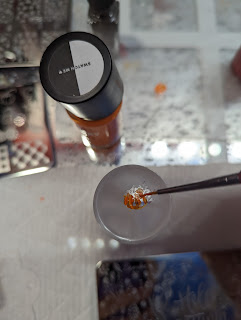If you have a design on your plate that you want to make multicolor on your nail, you're going to make a decal.
First start off just like you always would. Put some polish on the plate, scrape with your scraping plate, then pick it up with the stamper. Flip the stamper around to look at the design and make sure you're happy with it.
Once it dries just a little bit you are going to apply a bit of top coat directly on top of that stamp design, while it is still on the stamperhead. Use your special no streak top coat for this. You don't need a lot, just enough to thinly cover that design and protect it from the next paint. The reason is because applying wet paint over another layer of paint that was previously dry will re-wet it, causing the first color to bleed into the new one, streaking it. This ruins your work! No one wants streaking.
The above step is not always critically necessary, and perhaps after you have learned the basics you can skip it, but I believe it will help you succeed until you are more well practiced at this. It is easier to prevent messing up by using this clear coat paint over your stamp. This also allows you to use any nail polish - not just stamping polish - to color in designs with a small paintbrush. Stamping polish dries very quickly and is less likely to streak and smear. But regular nail polish does not. So when using it for filling in designs, that added layer of top coat can keep it looking good for you. Also note that non-stamping polish layers will take longer to dry on the decal itself before you apply it to your nail.
(In the video link below, they don't mention the clear coat step because they're taking care to blob the paint around, meaning gliding it over the top of the stamped design rather than ever letting the brush or tool rub the old/first paint layer, which helps to prevent it from smudging on you like this. Here your tool should never touch the image. You basically blob it on. You can try it both ways and see which works best for you, though! They're also using stamping polish, not "regular" nail polish.)
Now you can take any of your other nail polish and put a little dot out on some wax paper. Take a paintbrush, paint moving tool, etc and pick up the paint. Paint the design in on the stamper head. Don't get it too thick, as it takes a long time to dry. It might squish out later in undesired places when you apply it to the nail, if it's not dry.
When you're painting on the reverse, it's ok to paint over the original stamper lines while filling in your colors. As long as you don't go outside the lines, it won't show when the stamp gets reversed and put on the nail at the end. Fill in the design completely.
If you're using the right stamperhead you could actually look through the handle end and see the reverse side to check out your progress. If you do additional layers of hand painting in this manner, make sure to stop, let it dry, apply another layer of top coat over it, and let that dry.
By the way, these deco colors by LA Colors from the Dollar Tree work great for this! They have a long, narrow brush inside.
When you are done and ready to apply it to your nail, either put a fresh coat of paint on your nail and let it almost completely dry..... Or, apply a layer of sticky base coat, found at Maniology..... before putting this decal on your nail. It won't stick to a completely dry surface. Let the sticky base coat, or polish layer, dry most of the way before you apply the decal. The polish should be barely tacky to the touch, but not wet. If it's too wet you'll know after trying to apply the decal - it will slip and slide.
Apply the stamperhead carefully and with decent pressure to your nail and plant the image down. You can pat it with a finger to make sure it is down securely. It may go outside the bounds of your nail but that is okay. Take your cleanup brush and dip it in acetone and gently roll around the outside of your nail to dissolve the excess.
Finally you will just need to put a layer of top coat over it to protect it (remember, No Streak first!). And that's it!
Sometimes I might even stamp over that design after I've put it down (needs a sticky coat to hold it on) if I think the design wants a different outline, etc. Just take care to line it up good first. Again the clear ended stamper really helps with this since you can see exactly where things are going before you make contact.
This is where you pick up the outline from the plate, then use tools to paint in the colors by hand before stamping the design onto your nails.
Basically, this is stacking stamp designs on the stamper head before you apply it to your nail.
Making a Nail Decal could be confusing terminology because it shares the name of the rub-on type of decals. However this is really the same process as Reverse Stamping, except you can place your outline design onto a stamping mat surface and work on it to turn it into a decal from there, instead of doing it on the stamper head. Don't use no-smudge top coat when using this technique. Stamp the outline to the mat. Paint it in. Then, when dry, go over it with top coat (NON no-smudge). You can lift it off the mat when dry with tweezers much more easily when you've applied the clear coat. (If you use a non-smudge top coat on the mat over the decal, you won't be able to peel it off the mat. You might be able to, but it will more likely get damaged in the process.)
Now you can put sticky base coat on your nail, then apply the decal. You can use a stamper head to help press it down on the nail. Use your smudge-free top coat over the top for that final layer, and you're done! If the image is bubbled up or messy on your nail, use non no-smudge top coat to help "melt" the decal layer onto your nail, but take care to only "float" the brush over your design - don't touch the brush to the paint. Glide the clear polish over the top to cover it. This will take a bit longer to try since it is thicker so be careful with your hands for a while. :)
So, why would you want to make a Decal instead of just Reverse Stamping directly on the stamper, and putting on your nail now? You could make and then save your decals for later! Just be sure to store it somewhere in an airtight container to preserve it from becoming brittle.
What about the other type of decals? Those are sort of like stickers you incorporate into your designs. I don't work with this medium but you might like to give it a try. Check out Maniology's video for more:
https://www.youtube.com/watch?v=eS2_2UjUBzg











0 Comments